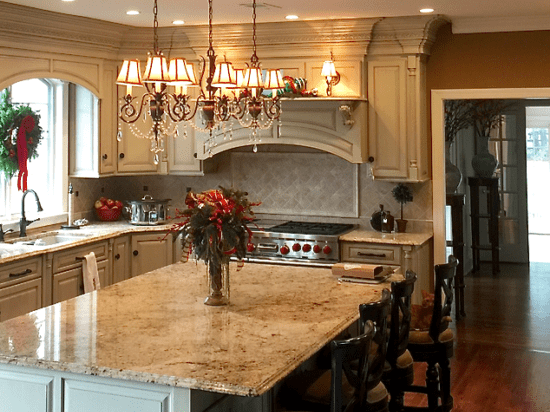For most natural stone kitchen countertops, seams — places where two individual stones are joined together — are often unavoidable. That sometimes seems strange to customers when they see the huge piece of stone their countertop will be made from. Can’t it just be cut in one piece? For smaller surfaces, like a bathroom vanity top, a seamless countertop is usually possible. However, larger kitchen countertops present more of a challenge. Let’s go over why seams are often necessary and how good stone fabricators can minimize their appearance.
Why seams?
For starters, natural stone (particularly granite) is quarried in 10-foot blocks. If you have a small kitchen countertop or just need a straight slab, it might be possible to cut it into one continuous piece. It really depends on the size of the countertop, the dimensions of the entryway and workplace, and also how many cutouts the stone will have. Cutouts, which you’d need for a sink or a cooktop, weaken the stone and can make the slab prone to breaking if it throws off the weight distribution of the piece. In this case, seams may be necessary to ensure the stone doesn’t break apart.
These considerations are especially important for L-shaped countertops. These pieces almost always need to be cut into at least two pieces, which can be done in a few different ways. Sometimes the stone will be cut on either side of the corner, making two distinct rectangular pieces and a single short, straight seam. In other instances, the stone will be cut at a 45-degree angle from the corner, which creates a mitered seam. If the fabricator can get away with it, the seams may be placed in a more inconspicuous place, such as in sink cutouts, under a cabinet, or near a column.
Another factor that will impact how and where your seams are placed is the pattern and coloring of the stone itself. Stones that have fine graining and are more consistent, even in color are easiest to seam, especially if the stone is dark. The epoxy used to fill the seams is tinted to match the color of the stone, and since the epoxy itself usually has a yellowish tinge to it, it can be difficult to color-match on lighter slabs.
Slabs that have large swaths of color, wider ranges of color, and intricate veining can be much more difficult to seam. In order to make the two pieces look as continuous as possible, the fabricator needs to make sure that the color is relatively continuous from one piece to the next and that the veining and coloration continue to flow as naturally as possible. The pieces will look very distinct and somewhat sloppy and mismatched if the color changes dramatically between seams, or if the veining or patterning changes abruptly. While it’s not always easy to make a completely flawless transition, a reputable fabricator will do his or her best to make it look like one continuous piece of stone.
How is the seam sealed?
As we said above, the two pieces of stone will be joined and filled with epoxy resin, which is colored to match the stone. If the stone has a lot of color variation, the fabricator may opt to use a clear resin or will use multiple colors to try to make the seam as invisible as possible. Generally, a seam should be less than 1/16th of an inch wide, and special machinery will be used to join and hold the two pieces to make the seam as narrow and tight as possible. After the epoxy is applied, any excess will be removed and the seam will be smoothed down. A good seam should be completely flat and flush with the countertop and should seem inconspicuous, if not invisible. A poor fabricator will leave a bumpy, visible seam, which will greatly diminish the look of the overall countertop. Natural stone is a great investment for your home, and you’ll definitely want to make sure the job is done right from beginning to end to ensure you’ve both gotten your money’s worth and to ensure your countertop is story and sound. Make sure to see pictures of previous work done by the stone manufacturer to make sure their seams are neat and clean. In fact, you shouldn’t be able to notice them at all!
Seams are often a necessary part of a quality natural stone countertop. Although you may worry that the seam will be obvious, a good fabricator knows how to make them nearly invisible. If you’re worried about how and where your countertop will be seamed, make sure you discuss your options with the fabricator to determine what will be the best option for your particular piece of stone.

